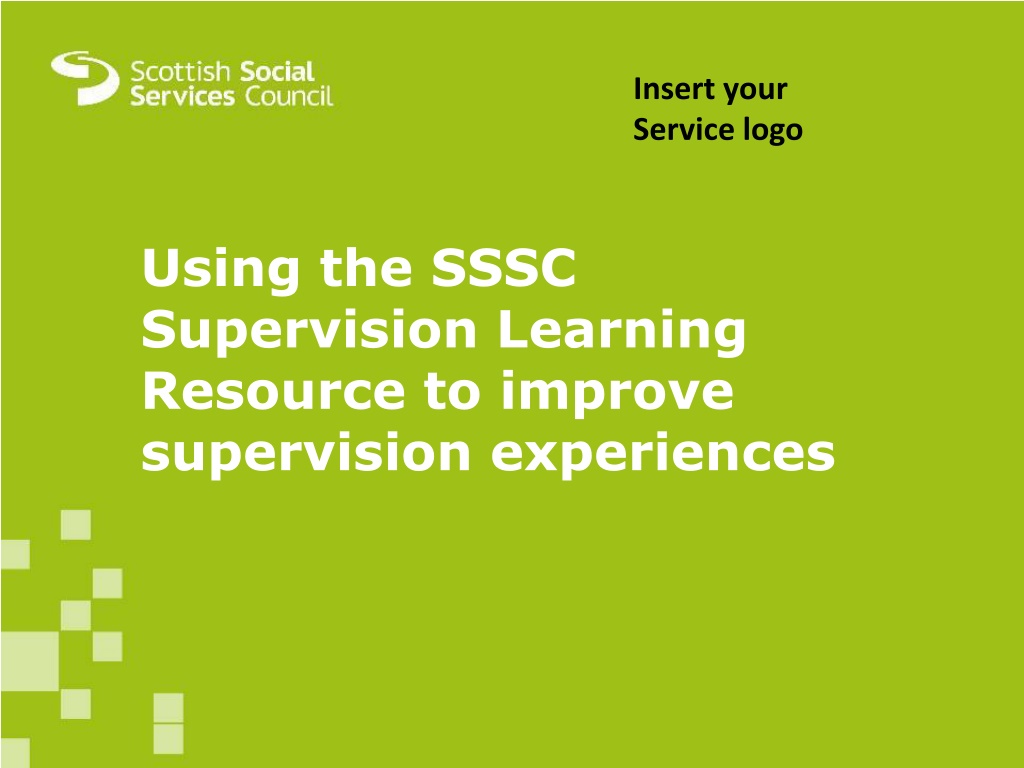Enhancing Supervision Experiences with SSSC Learning Resource
Explore the importance of supervision, positive relationships, and effective techniques using the SSSC Supervision Learning Resource. Gain a deeper understanding, improve your experiences, and maximize the benefits of supervision within your organization.
Download Presentation

Please find below an Image/Link to download the presentation.
The content on the website is provided AS IS for your information and personal use only. It may not be sold, licensed, or shared on other websites without obtaining consent from the author. Download presentation by click this link. If you encounter any issues during the download, it is possible that the publisher has removed the file from their server.
E N D
Presentation Transcript
Insert your Service logo MAIN HEADER GOES HERE Bullets and body text here. Using the SSSC Supervision Learning Resource to improve supervision experiences
WHAT YOULL GET OUT OF TODAY. A better understanding of what supervision is for. Look at how positive relationships impact on the quality of supervision. Feel more comfortable taking part in effective supervision. Be more aware of supervision changes within [insert your service name]
LETS START .. Imagine someone who has recently joined your team is spending a day with you to become familiar with the workplace and the job role. They have no previous experience of supervision and have asked you to explain what it s about. During a coffee break tell them what supervision is and what your experience is.
WHATS YOUR BEST EXPERIENCE OF SUPERVISION, A TIME WHEN YOU FEEL THAT IT WORKS WELL FOR PEOPLE? If possible, focus on a specific experience such as an actual supervision session. What is important? What makes it possible? What does it look and feel like?
WHAT IS SUPERVISION? MAIN HEADER GOES HERE Bullets and body text here.
DIFFERENT TYPES OF ONE-TO-ONE SUPERVISION Formal meeting set up between planned sessions Formal, planned, one-to-one sessions Planned informal sessions Ad-hoc informal discussion
COMING PREPARED AND MAKING THE MOST OF SUPERVISION MAIN HEADER GOES HERE Bullets and body text here.
A BALANCED SUPERVISION Management Mediation Competent (in) Accountable (for) Performance (in) Engaging with the organisation Upward and downward flow of information Development Support Continuing professional development Boundaries at work Personal and professional responses Morrison (2005)
EFFECTIVE SUPERVISION SUPPORTS: Health and Social Care Standards Codes of Practice Code 3: A social service employer must provide learning and development opportunities to enable social service workers to strengthen and develop their skills and knowledge. 3.14: I have confidence in people who support and care for me because they are trained, competent and skilled, are able to reflect on their practice and follow their professional and organisational codes. Code 6: As a social service worker, I am accountable for the quality of my work and will take responsibility for maintaining and improving my knowledge and skills.
A SPACE AND PLACE FOR DIFFICULT CONVERSATIONS MAIN HEADER GOES HERE When addressing issues of performance Bullets and body text here. Describe what the person is doing (or not doing) that is problematic. Explain why their behaviour or actions are problematic. Does this impact on people who use services, colleagues, staff from other agencies, the profession they represent or their employing organisation? Specify what they should be doing instead. Depending on the nature of the problem this may include the kind of support needed to help bring about change. Consequences what will the consequences be if they are unable or unwilling to change? Who else will become involved for example, HR and what are the required timescales for change to happen.
WHATS HAPPENING IN OUR SERVICE?
RESOURCES TO SUPPORT YOU Screen Shot 2018-03-05 at 12.15.18.png C:\Users\daltonlo\AppData\Local\Microsoft\Windows\Temporary Internet Files\Content.Outlook\IBIUX08A\gettingstarted.png Screen Shot 2018-03-05 at 12.17.58.png
WHAT NEXT? MAIN HEADER GOES HERE Bullets and body text here.
LINKS AND CONTACTS SSSC Supervision Learning Resource: http://www.stepintoleadership.info/supervision.html Leading change in supervision: https://www.iriss.org.uk/sites/default/files/iriss-leading- change-in-supervision-2015-07.pdf Achieving effective supervision: https://www.iriss.org.uk/resources/insights/achieving- effective-supervision enquiries@iriss.org.uk leadership@sssc.uk.com





























